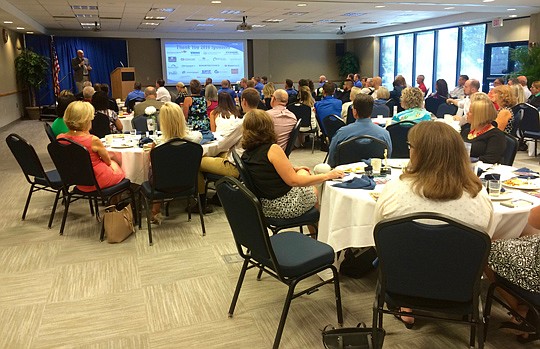
By Jamie Swann, Contributing Writer
In 1968, the Jacksonville International Airport opened its terminal doors, replacing the much smaller Imeson Field.
The seemingly sprawling, new airport made its home on 7,911 acres in what was then the heavily wooded, rural land on the Northside.
A few narrow roads winding through the tall pine trees led visitors to a single rectangular terminal building. The two paved runways were a stark contrast to the surrounding forestry.
Although the immediate future of the area was unclear, the city remained steadfast in the belief of “if you build it, they will come.”
It turned about to be true then — and still is now — in terms of growth at the airport and in nearby residential and commercial real estate developments.
Steven Grossman, CEO of the Jacksonville Aviation Authority, shared the story last month at a Northeast Florida Builders Association’s Sales and Marketing Council breakfast.
When the airport reached 2 million passengers in 1982, enhancements were needed to accommodate the growth and new jets being introduced into the airline industry.
And the growth of the airport has not slowed since then.
Currently transporting more than 5 million passengers yearly, a recent report predicted an increase of 2.5 percent growth in passenger traffic in the coming fiscal year.
“The airport is dependent on Jacksonville, as far as population and business,” said Grossman. “We grow as our market area grows.”
To keep up with the growth, the airport is consistently making improvements.
Adding new flights and airlines and updating baggage screening machines are just part of the expansion plan.
Grossman said the airport is building its international service, mostly with flights to the south.
“We have to be realistic about it,” he said. “We go where our customers go.”
With growth at the airport comes growth to the surrounding areas.
Small farms and isolated homes once dominated Oceanway, the area southeast of the airport.
Now, Oceanway is no longer the vast, remote land it once was.
With the addition of several neighborhoods, schools, the River City Marketplace and other commercial developments, the area is booming.
Soon to join that area is the Amazon.com fulfillment center on Pecan Park Road, which will bring 1,500 permanent jobs and hundreds more seasonal positions.
And the area’s growth all began with an airport.
“When it was under construction, JIA was located in an area that was just starting to become developed,” said Grossman. “By adding the airport, we added jobs to that area, creating a need for housing and shopping centers.”
Oceanway is home to slightly more than 5,000 residents. With its close proximity to Interstate 95 and the airport, the area has long been favored by developers searching for land to build their next subdivision.
The popularity of the Oceanway area is growing and the demand to be near the airport is high. Large amounts of land in the area are becoming harder to find, causing builders to branch out.
Seeing the potential in the area, subdivisions are popping up in bordering neighborhoods like Yellowbluff and New Berlin.
“As we bring companies to JIA or expand companies that we have, we are adding jobs,” began Grossman, “Adding jobs is going to drive up the housing market in that area.”
The market for new construction in the area isn’t slowing down. Builders like D.R. Horton, KB Home, Dream Finders Homes and SEDA — along with many others — have found a prime location for single-family communities.
Although the airport is not the sole reason for growth in the area, it does strongly impact it.
“The airport plays a substantial role on the economic growth and development of Jacksonville,” said Karen Everett with Clockwork Marketing Services. “A concern for key decision-makers at companies interested in relocating to the city is having direct flights available to other major cities. Having the flights available opens the door to huge opportunities for our city.”